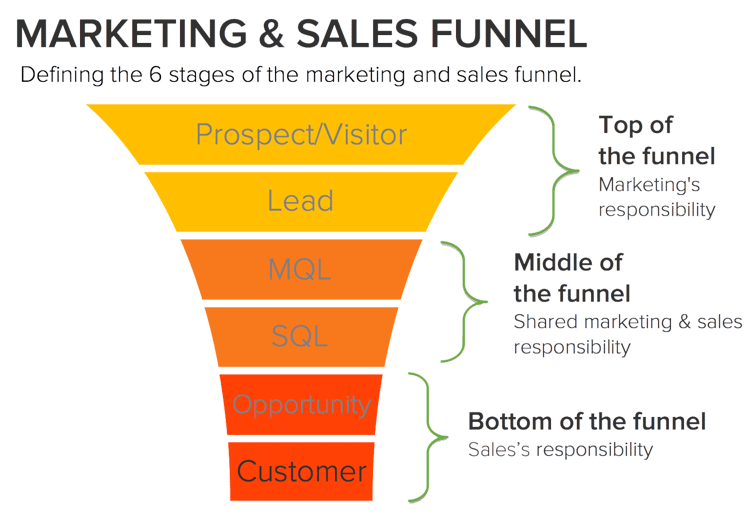

I have long been aware of the awkward tension between clients’ sales and marketing departments, and it’s only in recent years that I’ve come to understand why it exists. After all, these are two deeply inter-related and interdependent functions, both critical to the revenue pipeline.
Marketing and sales are essentially a relay team, created to collectively attract and convert new business. Their success, and that of the company, depends on it. So they ought to get along swimmingly.
But they seldom do. Marketing teams lament that sales leads are wasted by lazy or cherry-picking salespeople. And sales staff blame marketing, saying its scattergun targeting and spun copy result in crappy leads.
The two roles are so tightly connected, yet seldom work together harmoniously.
Ever wonder what would happen if they could?
The answer is actually quite remarkable.
An Aberdeen Group study found companies that successfully aligned their sales and marketing teams (in a process known as “smarketing”) grew revenue by and average of 32%. And those failing to do so experienced a 7% decline in revenue.
Supporting this with its own deep data, Hubspot reports that companies with strong smarketing practices enjoy 36% higher customer retention, 38% higher sales win rates and 208% more revenue than those that don’t.
Wow.
These are some staggering improvements when applied to any size of business: a level of change previously impossible to achieve with existing teams. But some powerful integration platforms have put it squarely within reach.
Oh, and best of all, it’s repeatable and fully scalable.
Smarketing is not smrocket science. Any company that employs good sales and marketing people can do it, and the benefits go far beyond increased sales and profitability. It’s also part of the inbound marketing methodology, through which you stand to make even more remarkable increases in lead generation and sales.
Here are 7 steps you need to follow to make your alignment a success:
1. Completely Redefine Your Buyer Personas
A common disparity between sales and marketing is that they often work from entirely different sets of buyer personas. Resolving this can be a great starting point for your alignment: create a discussion between sales and marketing (centred on real-world metrics and pipeline data) about what kind of customers are the most profitable, the easiest to close, and the most loyal – as well as the costly or counterproductive ones. You’ll be surprised how quickly the teams find common ground and build a mutual understanding of their goals. Agreeing upon and documenting what constitutes a good lead can eliminate one of the biggest friction points in a lasting way.
2. Agree on messaging and content strategy
I have often noticed at my Edmonton web design and marketing agency that our clients’ sales and marketing teams tend to evolve their own internal languages and separate sets of content assets. So why are we surprised when sales teams disagree with (and resent) the messaging, hooks and promises created by marketing? A content audit involving both teams can identify the differences as well as common ground, and pave the way to more consistent and effective messaging at all stages in the pipeline.
3. Achieve Shared Definitions
It’s also not unusual for sales and marketing to have radically different definitions of what qualifies (and disqualifies) a lead, and conflicting perceptions of lead management stages. It is imperative that both sides agree on and document what constitutes a "sales-qualified” lead to eliminate conflicts about prioritization and discarding of leads. Because once the sales team no longer believes most sales-qualified leads are junk, and marketing stops expecting its lead-generation triumphs to be squandered by sales, that energy can be channeled to do some amazing things.
4. Use a Single Dashboard
We know that in order to be continuously singing from the same songsheet, a unified language and definitions are foundational. And to close the loop, you need a common set of measurements, applied consistently. Platforms like Hubspot include comprehensive sales and marketing dashboards that provide exactly the kind of metrics your teams need to monitor their shared progress, identify lead sources, score leads, track follow-ups and analyze which campaigns are working. When everyone is looking at the same metrics and data, it becomes natural to work harmoniously.
5. Unite the Sales Funnel
A major disconnect arises when sales and marketing efforts are tracked and recognized separately. When you consider the potential synergies, it makes sense to go a step further and view sales and marketing as one fully integrated sales funnel, with marketing at the top, a shared area in the middle, and a clear hand-off when a prospect advances from a marketing-qualified lead (MQL) to a sales-qualified lead (SQL) – according to those unified definitions you’ve created. The aligned smarketing team shares the glory of each win.

6. Agree on Goals and Quotas
Next, the sales and marketing teams need to agree on what each will achieve. This can be quantified in a Service Level Agreement (SLA) as the number of sales-qualified leads marketing will generate per month, and the follow-up process for each one. Defining joint success in a measurable, quantitative and clearly documented fashion makes it much easier to avoid finger-pointing.
7. Evaluate Frequently Together
Regular meetings of both teams are important to keep everyone on track, engaged, and enthused about the new approach. Celebrating wins together and analyzing conversion rates at different stages in the pipeline can help fine-tune your methodologies and resolve flaws in the initial beliefs while cementing a bond between the two teams. The collaborative approach will bring out smarter insights and more creative solutions than you’ve ever had before.
There is so much to gain by synchronizing sales and marketing teams that it’s irresponsible to postpone your alignment plan. In addition to the productivity gains, valuable lessons will be learned for the enterprise, and everyone’s job satisfaction will visibly improve. Nobody really liked the blame game anyway – success is infinitely more fun!
Looking for ways to supercharge your company’s lead generation? Click the pink button to download my free eBook and get 26 proven tips, tricks and tactics for increasing your flow of quality leads! And if you have questions about aligning sales and marketing, post a comment below or drop me a line.
Laurier Mandin is president of Graphos, the Edmonton web design company, branding consultancy and inbound marketing agency he founded in 1993.
Laurier Mandin is president of Graphos, the Edmonton web design company, branding consultancy and digital marketing agency he founded in 1993.
